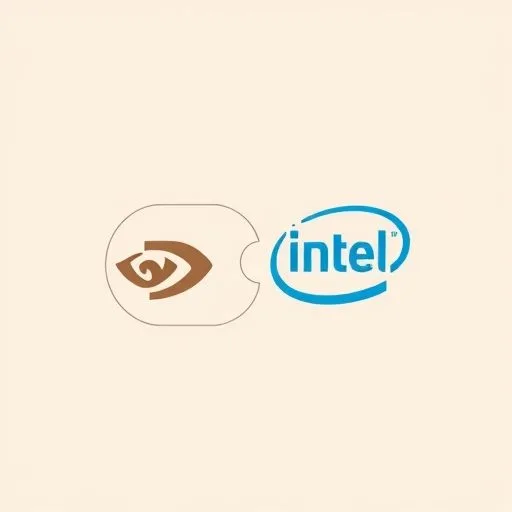
Brrr, that crisp September air this morning—22 degrees of gray, overcast weather that’s perfect for reflecting as I walked my daughter to school (yep, just past the park where she still insists squirrels deliver her lost hair clips). Over my shoulder, the radio crackled: ‘Nvidia just dropped $5 BILLION on Intel to build AI-powered laptops we’ve never seen!’ My coffee froze mid-sip. Not ‘Whoa, stock prices!’—but ‘That’s a game-changer… does this mean MORE screen time battles for us parents?‘ Let’s unpack this like we’re sorting Lego bins: with messy hands, hopeful hearts, and zero tech jargon. Because here’s what hit me walking home: this isn’t about corporations. It’s about how next-gen creative AI tools could finally help our kids build dragons instead of just scrolling through them. But what does this mean for us as parents? Let’s explore how this partnership could change the way we think about screen time and creativity.
What’s the Real Deal Behind Nvidia and Intel’s AI Partnership?

Okay, let me be honest: when I first heard ‘Nvidia x Intel x $5 billion,’ my brain flashed to those long, boring meetings where ‘synergy’ gets tossed around like confetti at a spreadsheet party. But friends? This is different.
See, these giants aren’t just swapping cash—they’re fusing Intel’s everyday-computer brains with Nvidia’s AI magic to create gadgets that actually understand what humans need. Think: laptops that learn your kid’s drawing style to suggest new creative AI art tricks, or parental controls that don’t feel like prison bars but gentle guides saying, ‘Hey, maybe build that robot after veggies?’
Why does this matter in our daily lives? Remember how we navigate parenting—short walks to school, quick stops at the playground, that beautiful sense of community where the kind lady at the bakery knows if your kid needs an extra sweet treat? Screen time solutions should fit here, not fight it.
This deal? It’s a crack in the door for AI that respects our rhythms. Not the kind that drills math at 8 PM, but the kind that helps my daughter turn sidewalk chalk into animated stories. Suddenly, ‘AI for businesses’ feels less like boardrooms and more like our backyard sandbox.
How Can AI Transform Screen Time Into Family Creation Time?

Picture this: raining Sunday at home. My daughter’s sprawled on our warm floor, finger-painting rainbows while I’m knee-deep in a work ‘data dive’ (hey, someone’s gotta keep the pancakes coming). She tugs my sleeve: ‘Appa, can your computer make my dragon fly?’ Not ‘buy me a game’—create with me. That’s the shift in parenting balance I’m excited about!
Here’s why the Nvidia-Intel news lights me up like a festival of lights: real AI should be a co-creator, not a babysitter. Imagine her tablet recognizing her doodles and whispering, ‘What if this dragon had wings inspired by maple leaves?’—fusing traditional paper textures with autumn colors. Or tools that auto-translate playground banter during international playdates at the local park. But how can we make sure that this technology is used in a way that enhances our family time, rather than detracting from it?
This isn’t sci-fi; it’s the heartbeat of what those billions could unlock for AI family co-creation.
But I had some fears too. Will AI make my kid a screen zombie? I felt that way until I realized: when we design tech for play, not instead of it, magic happens. Like how we use travel maps: they guide our adventures but never replace the joy of getting lost together in a charming district. Same principle. AI as our family’s compass, not its cage.
Can AI Parenting Tools Reduce Screen Guilt and Boost Connection?

You know what hit me walking home from school today? The news isn’t about stock prices—it’s about that deep connection when the world finally ‘gets’ us. Intel’s x86 chips power most office laptops globally. Nvidia’s AI cooks our digital brains. When they combine, it means next-gen AI won’t be locked away in expensive gadgets. It’ll be in everyday things—like the computers your kid uses at school for science projects.
Think of it like this: remember when smartwatches first came out? They were high-tech devices. Now? My step-counter nudges me to take the scenic route home past the pond with my daughter—just to hear her giggle at waddling babies. That’s the shift we need. Not AI that demands attention, but tech that helps us connect more.
Imagine school projects where AI helps turn her ‘I drew a volcano!’ into a 3D animation with real eruption sounds… then saves the file so we can watch it over dinner. Tech that serves our kitchen table, not the other way around.
Here’s my wild hope for screen time solutions: what if these ‘laptops we’ve never seen’ actually reduce screen guilt? Tools that auto-suggest: ‘Family walk time!’ when your kid’s drawn 10 rainbows today. Or gently fade apps to ‘Let’s build a fort!’ mode after 30 minutes. Not punishment—invitations to live. Oh my gosh YES! That’s the parenting change we can find in the headlines. So, what does this mean for the future of parenting in the age of AI?
3 Ways to Embrace AI Parenting Balance Without the Hype

I know—‘Another tech trend to explore!’ But here’s where we find the good in the noise. First, look for AI that inspires creativity. When new gadgets drop, ask: ‘Does this spark creation or just consumption?’ If your kid is designing a robot dog, that’s great! If they’re mindlessly swiping, maybe it’s time to find a new app. (A helpful hint: I test apps by asking, ‘Could we recreate this joy with sidewalk chalk?’)
Second: talk tech in playground language. At the neighborhood playground yesterday, I overheard parents fretting about AI homework helpers. So I shared: ‘What if we think of it like baking? Nvidia and Intel are combining Intel’s chips and Nvidia’s AI to create something better—helping us nourish, not replace, the baker (YOU!).’ Suddenly, the panic turned to nods. Your move: swap corporate jargon for ‘Remember how we blend new flavors into old recipes? AI’s just another ingredient for creative tech.’
Most importantly: protect the joy of discovery. The Nvidia news made me sprint home and grab my daughter’s hand: ‘Dragon-drawing time!’ Why? Because no AI can replace the joy in her eyes when she makes paper wings flutter. Let’s champion tools that fuel that fire—not smother it. As my grandma used to say, ‘Technology is a tool. We control it, or it controls us.’ Today, we’re taking control with hope, not fear.
As we navigate this new world of AI and technology, let’s remember to stay focused on what’s truly important: our connection with our children and the joy of discovery. With hope and a little bit of creativity, we can turn this challenge into an opportunity for growth and learning.
Source: What Nvidia’s stunning $5 billion Intel bet means for enterprise AI and next-gen laptops, Zdnet, 2025-09-18
